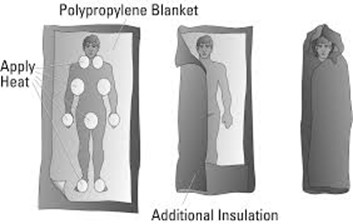It looks like another harsh winter, with ice storms and blizzards already carpeting much of the Midwest, Northeast and Canada, and cold weather preparedness
is a must for survival. Failure to use precautions will lead to a condition called hypothermia. Hypothermia is a condition where the core body temperature drops below 95 degrees Fahrenheit. The normal body core temperature is defined as between 97.5-99.5 degrees Fahrenheit (36.0-37.5 degrees Celsius).
In your efforts to be medically self-reliant, one of the major factors that must be taken into consideration is your environment. If you haven’t prepared for the weather, you have made your environment your enemy, and it is a formidable one. The last ice storm caused 27 deaths, some of which were avoidable. Therefore, it’s important to be prepared to prevent death from exposure and to know how to treat someone who is hypothermic.
HOW YOUR BODY LOSES HEAT
Your body has various methods it uses to control its internal “core” temperature, either raising it or lowering it to appropriate levels. The body “core” refers to the major internal organ systems that are necessary to maintain life, such as your brain, heart, liver, and others.
In cold weather, your blood vessels constrict to conserve heat. Muscles “shiver” as a method of heat production. You can voluntarily increase heat by exertion; it is recommended to “keep moving” in cold environments for this reason. Part of the healthcare provider’s role is to educate each and every member of their family or group on proper planning for outdoor activities. Monitor weather conditions as well as the people you’re sending out in the heat or cold.
The body loses heat in various ways:
Evaporation – the body perspires (sweats), which releases heat from the core.
Radiation – the body loses heat to the environment anytime that the ambient (surrounding) temperature is below the core temperature (say, 98.6 degrees Fahrenheit). For example, you lose more heat if exposed to an outside temperature of 20 degrees F than if exposed to 80 degrees F.
Conduction – The body loses heat when its surface is in direct contact with cold temperatures, as in the case of someone falling from a boat into frigid water. Water, being denser than air, removes heat from the body much faster.
Convection – Heat loss where, for instance, a cooler object is in motion against the body core. The air next to the skin is heated and then removed, which requires the body to use energy to re-heat. Wind Chill is one example of air convection: If the ambient temperature is 32 degrees F but the wind chill factor is at 5 degrees F, you lose heat from your body as if it were actually 5 degrees F.
Most heat is lost from the head area, due to its large surface area and tendency to be uncovered. Direct contact with anything cold, especially over a large area of your body, will cause rapid cooling of your body core temperature. The classic example of this would be a fall into cold water. In the Titanic sinking of 1912, hundreds of people fell into near-freezing water. Within 15 minutes, they were probably beyond medical help.
PHYSICAL EFFECTS OF HYPOTHERMIA
Aside from shivering, the most noticeable symptoms of hypothermia will be related to mental status. The person may appear confused, uncoordinated, and lethargic. As the condition worsens, speech may become slurred; the patient will appear apathetic and uninterested in helping themselves, or may fall asleep. This occurs due to the effect of cooling temperatures on the brain; the colder the body core gets, the slower the brain works. Brain function is supposed to cease at about 68 degrees Fahrenheit, although I have read of exceptional cases in which people (usually children) have survived even lower temperatures.
To prevent hypothermia, you must anticipate the climate that you will be traveling through, including wind conditions and wet weather. Condition yourself physically to be fit for the challenge. Travel with a partner if at all possible, and have enough food and water available for the entire trip.
PREVENTION STRATEGIES FOR HYPOTHERMIA
In your efforts to be medically self-reliant, one of the major factors that must be taken into consideration is your environment. If you haven’t prepared for the weather, you have made your environment your enemy, and it is a formidable one.
Remember the simple acronym C.O.L.D. This stands for: Cover, Overexertion, Layering, and Dry:
Cover. Protect your head by wearing a hat. This will prevent body heat from escaping from your head. Instead of using gloves to cover your hands, use mittens. Mittens are more helpful than gloves because they keep your fingers in contact with one another. This conserves heat.
Overexertion. Avoid activities that cause you to sweat a lot. Cold weather causes you to lose body heat quickly, and wet, sweaty clothing accelerates the process. Rest when necessary; use rest periods to self-assess for cold-related changes. Pay careful attention to the status of your elderly or juvenile group members.
Layering. Loose-fitting, lightweight clothing in layers insulate you well. Use clothing made of tightly woven, water-repellent material for protection against the wind. Wool or silk inner layers hold body heat better than cotton does. Some synthetic materials work well, also. Especially cover the head, neck, hands and feet.
Dry. Keep as dry as you can. Get out of wet clothing as soon as possible. It’s very easy for snow to get into gloves and boots, so pay particular attention to your hands and feet.
Any unconscious person that you encounter in a cold environment is hypothermic until proven otherwise. Immediate action must be taken to reverse the ill effects.
TREATMENT OF HYPOTHERMIA
A person who is hypothermic is in danger of losing their life without your help. Important measures to take are:
Get the person out of the cold and into a warm, dry location. If you’re unable to move the person out of the cold, shield him or her from the cold and wind as much as possible.
Take off wet clothing. If the person is wearing wet clothing, remove them gently. Cover them with layers of dry blankets, including the head (leave the face clear). If you are outside, cover the ground to eliminate exposure to the cold surface.
Monitor breathing. A person with severe hypothermia may be unconscious. Verify that the patient is breathing and check for a pulse. Begin CPR if necessary.
Share body heat. To warm the person’s body, remove your clothing and lie next to the person, making skin-to-skin contact. Then cover both of your bodies with blankets. Some people may cringe at this notion, but it’s important to remember that you are trying to save a life. Gentle massage or rubbing may be helpful, but vigorous movements may traumatize the patient
Give warm oral fluids. If the affected person is alert and able to swallow, provide a warm, nonalcoholic, non-caffeinated beverage to help warm the body. Remember, alcohol does not warm you up!
Use warm, dry compresses. Use a first-aid warm compress (a fluid-filled bag that warms up when squeezed), or a makeshift compress of warm (not hot) water in a plastic bottle. Apply a compress only to the neck, chest wall or groin. These areas will spread the heat much better than putting warm compresses on the extremities, which sometimes worsens the condition.
Avoid applying direct heat. Don’t use hot water, a heating pad or a heating lamp to warm the person. The extreme heat can damage the skin, cause strain on the heart or even lead to cardiac arrest. Don’t rub on extremities that may be frostbitten, as the skin is already traumatized and the condition may be worsened.
Don’t give alcohol. You have all seen photos of St. Bernards with casks of brandy around their necks for lost alpine travelers. Alcohol may give you a warm and fuzzy feeling, but it also expands blood vessels, which causes heat loss!

No Alcohol for Hypothermia! Bad Dog!
If left untreated, hypothermia leads to complete failure of various organ systems and to death. Make sure your people are well clothed for the temperature, and monitor them closely if they are outside for extended periods of time in cold weather.
Start now to make sure you are staying prepared.
Via: doomandbloom






 Follow
Follow
Leave a Reply